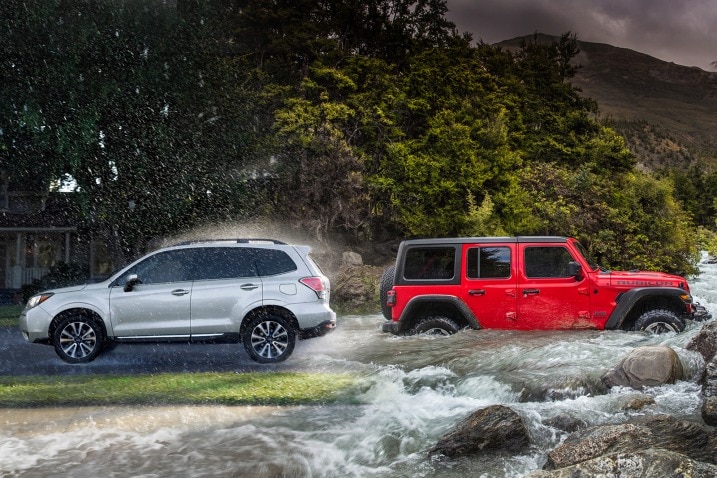How does four-wheel drive work?
Like AWD systems, 4WD is designed to maximize traction front and rear. But 4WD systems tend to be more robust than AWD ones and can generally handle more rugged terrain. And they, too, come in two types: full-time and part-time.
Traditional 4WD systems have a two-speed transfer case with high- and low-range modes that can be selected by the driver, either with an electronic switch or a mechanical lever. The low-range setting multiplies torque to provide superior control and grunt in low-speed off-road environments. The high-range setting is useful for less challenging off-road scenarios as well as slippery on-road conditions, such as packed snow, ice, loose sand or gravel.
Full-time four-wheel drive: Full-time 4WD operates as a full-time AWD system does, with all four wheels receiving power on a continuous basis. Late-model Toyota Land Cruisers are a good example — they send power to both the front and the rear by default, so there is no standard two-wheel-drive mode (unlike typical 4x4 trucks with their part-time systems), but there's also a selectable low range for the really tough off-road stuff. In some designs, the driver may have the additional option of controlling how power is apportioned to the front and rear axles through selectable modes and locking differentials.
Part-time four-wheel drive: This type is the real traditionalist of four-wheel propulsion and can most often be found in trucks and SUVs that are designed to work and play in extreme conditions. In this case, the vehicle is typically rear-wheel drive by default, so the four-wheel-drive system requires the driver to opt in by either pushing a button or shifting a lever. Locking center differentials are par for the course, but many part-time 4WD systems also allow the driver to lock the vehicle's rear differential, which ensures that both rear wheels get power no matter what. Hardcore setups let you lock the front differential, too — this is the hallowed "triple-locked" configuration that means you'll only get stuck if all four wheels have no traction.
Four-wheel-drive pros and cons
There's no substitute for true 4WD in tough off-road scenarios. Even though 4WD systems are now available in well-appointed luxury trucks and SUVs, at heart they are designed for ruggedness and maximum traction when you need it most, so they are the right choice for difficult terrain.
These days, 4WD design has become increasingly refined, as has the design of the vehicles that can be ordered with it. But depending on the make and model, 4WD vehicles often deliver a stiffer ride than their two-wheel-drive counterparts. These systems also have a detrimental effect on fuel economy and increase the initial cost of the vehicle.
Is 4WD or AWD better in snow?
A couple of things to keep in mind up front: Whether you choose AWD or 4WD, any vehicle can lose traction and spin out if pushed hard enough. And while both systems are designed to increase traction by engaging the front and rear wheels, neither helps you stop better in snow; winter tires do. Having said that, both AWD and 4WD can give you a significant advantage in snowy and icy conditions and may be worth the extra cost depending on where you live and how you use your vehicle.
Driving in cold weather often means encountering a variety of rapidly changing road surfaces, from soft snow to hard-packed snow to glare ice. AWD and full-time 4WD systems, which deliver power to all four wheels all the time or automatically engage four-wheel torque when needed, are best at dealing with these changing conditions. When paired with a good set of winter tires, AWD vehicles take the guesswork out of the equation and can act more quickly than a driver to handle variable road surfaces.
On the other hand, 4WD is generally well suited to navigating deeper snow or other more extreme winter conditions. It can get you unstuck from a snowdrift more easily, manage icy hills more effectively, and get you to work safely before the roads are plowed.
That said, numerous studies have shown that in order to maximize the full potential of AWD or 4WD in the snow, the vehicle needs to be equipped with a good set of winter tires. Similar studies have also shown that a front-wheel-drive vehicle equipped with winter tires can have its own strengths in the snow — it is less likely to experience oversteer, and its braking distances are comparable to those of an AWD vehicle in heavy braking.
Which is better: 4WD or AWD?
Not surprisingly, the answer to the AWD vs. 4WD debate is: It depends. More specifically, it depends on where you live and what kinds of driving conditions you encounter, as well as personal taste.
AWD can be found in cars, trucks and SUVs of all sizes, from compact to full-size, giving you the widest possible range of vehicles to choose from. It delivers increased traction in normal winter conditions or light off-roading and provides the fewest compromises in ride and fuel economy on dry roads. And it has the advantage of either continuously powering all four wheels or automatically controlling which corner gets the torque, taking the decision-making process out of the driver's hands.
But 4WD is still the better choice for those who need to work in extreme weather conditions or enjoy off-road adventuring. This system often comes in trucks and SUVs with higher ground clearance than average, making them well suited to managing deep snow, rocky terrain and steep grades, as well as carrying or towing heavy loads. In addition, the two-speed transfer case with low- and high-range gearing gives the driver the greatest amount of control over where and how the power is delivered, especially when paired with multiple locking differentials.



 by
by 